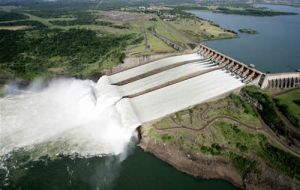MercoPress. South Atlantic News Agency
In a decade Brazil must increase power generating capacity by 56%
 The world’s largest operation hydroelectric dam, Itaipú
The world’s largest operation hydroelectric dam, Itaipú Brazil must expand electricity production over the next decade by an amount equivalent to the power generated by three Itaipú hydroelectric dams, according to a study released Wednesday by the state-run Energy Research Corporation, EPE.
Electricity consumption in Brazil will grow at an average rate of 4.5% annually over the next 10 years, climbing from 472.000 GWh in 2011 to 736.000 GWh in 2021, EPE said in the report.
That means that electricity demand in 2021 will be 56% higher than last year and that Brazil will have to increase its electricity production by 264,000 GWh over the next decade to keep pace.
That total is equivalent to almost triple the amount currently produced by Itaipú, which is jointly owned by Brazil and Paraguay and is the world’s second-largest hydroelectric power station by total capacity after China’s Three Gorges Dam.
With 92,245 GWh of electricity generated last year, Itaipú was the world’s largest hydroelectric facility in terms of annual generating capacity.
Brazil is counting on three large dams being built in the Amazon region and scheduled to come online in the coming years – Belo Monte, Santo Antonio and Jirau – to meet a portion of the additional electricity demand.
The largest of those is Belo Monte, a project on the Xingu River that has come under heavy criticism from environmentalists and local Indians and which is to generate 39,360 GWh starting in 2015.
EPE expects the annual rise in Brazilian electricity consumption to be less than average annual GDP expansion in the same period, which it estimates will be 4.7%.
The commercial sector will account for the largest share of growth in electricity consumption over the next decade (5.8% annually), followed by the residential sector (4.5%) and industry (4.4%).
“Despite the elevated increase in consumption by the commercial sector and services, industry will remain the sector responsible for almost half of the country’s total electricity consumption in 2021,” the study says.
Electricity consumption by the industrial sector is projected to climb from 225,000 GWh in 2011 to 346,000 GWh in 2021.




Top Comments
Disclaimer & comment rules-

-

-

Read all commentsAnd posters wonder why I am in favour of the immediate development of the Rio Xingo hydroelectric scheme!
Jan 05th, 2012 - 11:42 am 0Itiapu is in the hands of three nations and is always subject to political whim. Xingo is all-Brasilian.
Forest damage? - well, forests are usually located where there is water, so most schemes affect standing woodlands, but new impoundments give new fisheries, new communities and new industries. This is what 'development' is all about.
Once built, the scheme(s) provide(s), to all intents and purposes, 'carbon neutral' pollution-free energy.
This allows Brasil's oil/gas (carbon & pollution rich) to be used for higher grade purposes - plastics, pharmaceuticals, etc, rather than just for polluting burning.
I have a theory about the environmental movement, I consider it a well planned move by the developed countries, while they exploit their natural resources they say to us that we take care of nature, we have a sustainable development, etc.. That is, when the North has been squeezed the most of their land and there is nothing left there to be exploited, come by our resources wisely make us care for them.
Jan 05th, 2012 - 05:21 pm 0That heat .. I think today I will also go to the beach ..
Excuse my bad English.
Excused ;-)
Jan 05th, 2012 - 08:24 pm 0No country is a homogeneous whole. In big countries there are big industrial sectors and big environmental movements. The big and long established industry stimulates through industrialisation of national landscapes big and reactive environmental movements.
Environmentalists rapidly come to the conclusion that the damage cannot be contained within their national boundary and the solutions cross borders also.
So looking at eg. Brasil for its huge scope for solutions is entirely logical. Much forest for carbon capture, much water for non-polluting energy. You can understand how 'carbon trading' came along if you follow my argument - offsetting carbon use and forest destruction elsewhere by giving benefits to Brasil for conserving and 'planting'. The trouble is that certain sectors and individuals in Brasil prefers to deforest and despoil also. The hundreds of young Brasilian graduate Conservation Managers can do just so much, and finds it hard when the regional authorities are corrupt and in the pockets of the despoilers. The Federal protection authorities are similarly compromised.
The country NEEDS Dilma. She has the admin capabilities to turn things around. She needs support and constantly being persuaded in the 'right' directions. This is the job of ALL educated Brasilians.
Commenting for this story is now closed.
If you have a Facebook account, become a fan and comment on our Facebook Page!